Preparation, Structural Characterization and Evaluation of Some Dynamic and Rheological Properties of a New Type of Clay Containing Mastic Material, Clay-Mastic
Abstract
1. Introduction
2. Materials and Methods
2.1. The Preparation of Organo-Clay
2.2. Preparation of Organoclay-Bituminous Mastic Material
2.2.1. The Penetration Index (PI)
2.2.2. Penetration Viscosity Number (PVN)
2.3. High Resolution Transmittance Electron Microscopy (HRTEM) Analysis
2.4. Scanning Electron Microscopy (SEM) Analysis
2.5. X-ray Powder Diffraction Spectroscopy (XRD) Analysis
3. Results and Discussion
3.1. High Resolution Transmission Electron Microscope (HRTEM) Analysis of Organo-Clay (OMMT)
3.2. X-ray Powder Diffraction (XRD Analysis of Mastic Mixtures Prepared at Different Filler/Binder (Organo-Clay/Bitumen) Ratios
3.3. Scanning Electron Microscopy (SEM) Analysis of Mastic Mixtures Prepared in Different Filler/Binder (Organo-Clay/Bitumen) Ratios
3.4. Empirical Rheological Tests and Results
4. Conclusions
Author Contributions
Funding
Data Availability Statement
Acknowledgments
Conflicts of Interest
References
- Buttlar, W.G.; Bozkurt, D.; Al-Khateeb, G.G.; Waldhoff, A.S. Understanding Asphalt Mastic Behavior through Micromechanics. Transp. Res. Rec. 1999, 99, 157–169. [Google Scholar] [CrossRef]
- Melotti, R.; Santagata, E.; Bassani, M.; Salvo, M.; Rizzo, S. A preliminary investigation into the physical and chemical properties of biomass ashes used as aggregate fillers for bituminous mixtures. Waste Manag. 2013, 33, 1906–1917. [Google Scholar] [CrossRef] [PubMed]
- Faheem, A.F.; Bahia, H.U. Modelling of Asphalt Mastic in Terms of Filler-Bitumen Interaction. Road Mater. Pavement Des. 2010, 11, 281–303. [Google Scholar] [CrossRef]
- Woodward, D.; Woodside, A.; Jellie, J. Clay in rocks. Lect. Pap. Ser. 2002, 124, 1–12. [Google Scholar]
- Wang, H.; Al-Qadi, I.L.; Faheem, A.F.; Bahia, H.U.; Yang, S.; Reinke, G.H. Effect of Mineral Filler Characteristics on Asphalt Mastic and Mixture Rutting Potential. J. Transp. Res. Board 2011, 2208, 33–39. [Google Scholar] [CrossRef]
- Craus, J.; Ishai, I.; Por, N. Selective Sorption in Filler-Bitumen Systems. J. Mater. Sci. 1979, 14, 2195–2204. [Google Scholar] [CrossRef]
- Aliha, M.R.M.; Fakhri, M.; Kharrazi, E.H.; Berto, F. The effect of loading rate on fracture energy of asphalt mixture at intermediate temperatures and under different loading modes. Frat. Ed Integrità Strutt. 2018, 12, 113–132. [Google Scholar] [CrossRef]
- Aliha, M.R.M.; Shaker, S.; Keymanesh, M.R. Low temperature fracture toughness study for bitumen under mixed mode I+ II loading condition. Eng. Fract. Mech. 2019, 206, 297–309. [Google Scholar] [CrossRef]
- Aliha, M.R.M.; Ziari, H.; Mojaradi, B.; Sarbijan, M.J. Heterogeneity effects on mixed-mode I/II stress intensity factors and fracture path of laboratory asphalt mixtures in the shape of SCB specimen. Fatigue Fract. Eng. Mater. Struct. 2019, 43, 586–604. [Google Scholar] [CrossRef]
- Ameri, M.; Nowbakht, S.; Molayem, M.; Aliha, M.R.M. Investigation of fatigue and fracture properties of asphalt mixtures modified with carbon nanotubes. Fatigue Fract. Eng. Mater. Struct. 2016, 39, 896–906. [Google Scholar] [CrossRef]
- Androjić, I.; Kaluđer, G.; Komljen, M. Usage of the Fly Ash in Hot Asphalt Mixes. In Proceedings of the XXVIII International Baltic Road Conference, Vilnius, Lithuania, 26–28 August 2013; pp. 26–28. [Google Scholar]
- Arabani, M.; Tahami, S.A. Assessment of mechanical properties of rice husk ash modified asphalt mixture. Constr. Build. Mater. 2017, 149, 350–358. [Google Scholar] [CrossRef]
- Brown, S.; Needham, D. A study of cement modified bitumen emulsion mixtures. Asph. Paving Technol. 2000, 69, 92–121. [Google Scholar]
- Fakhri, M.; Kharrazi, E.H.; Aliha, M.R.M. Mixed mode tensile–In plane shear fracture energy determination for hot mix asphalt mixtures under intermediate temperature conditions. Eng. Fract. Mech. 2018, 192, 98–113. [Google Scholar] [CrossRef]
- Fakhri, M.; Bahmai, B.B.; Javadi, S.; Sharafi, M. An Evaluation of the Mechanical and Selfhealing Properties of Warm Mix Asphalt Containing Scrap Metal Additives. J. Clean. Prod. 2020, 253, 119963. [Google Scholar] [CrossRef]
- Garcia, A.; Austin, C.J.; Jelfs, J. Mechanical properties of asphalt mixture containing sunflower oil capsules. J. Clean. Prod. 2016, 118, 124–132. [Google Scholar] [CrossRef]
- Korayem, A.H.; Ziari, H.; Hajiloo, M.; Moniri, A. Rutting and fatigue performance of asphalt mixtures containing amorphous carbon as filler and binder modifier. Constr. Build. Mater. 2018, 188, 905–914. [Google Scholar] [CrossRef]
- Ma, T.; Wang, H.; Zhang, D.; Zhang, Y. Heterogeneity effect of mechanical property on creep behavior of asphalt mixture based on micromechanical modeling and virtual creep test. Mech. Mater. 2017, 104, 49–59. [Google Scholar] [CrossRef]
- Poulikakos, L.D.; Dos Santos, S.; Bueno, M.; Kuentzel, S.; Hugener, M.; Partl, M.N. Influence of short- and long-term aging on chemical, microstructural and macro-mechanical properties of recycled asphalt mixtures. Constr. Build. Mater. 2014, 51, 414–423. [Google Scholar] [CrossRef]
- Shaker, S.; Aliha, M.R.M.; Keymanesh, M.R. Aging effect on combined mode fracture resistance of bitumen. Fatigue Fract. Eng. Mater. Struct. 2019, 42, 1609–1621. [Google Scholar] [CrossRef]
- Wu, S.P.; Pang, L.; Mo, L.T.; Chen, Y.C.; Zhu, G.J. Influence of aging on the evolution of structure, morphology and rheology of base and SBS modified bitumen. Constr. Build. Mater. 2009, 23, 1005–1010. [Google Scholar] [CrossRef]
- Zarei, S.; Ouyang, J.; Yang, W.; Zhao, Y. Experimental analysis of semi-flexible pavement by using an appropriate cement asphalt emulsion paste. Constr. Build. Mater. 2020, 230, 116994. [Google Scholar] [CrossRef]
- Ziari, H.; Aliha, M.R.M.; Moniri, A.; Saghafi, Y. Crack resistance of hot mix asphalt containing different percentages of reclaimed asphalt pavement and glass fiber. Constr. Build. Mater. 2020, 230, 117015. [Google Scholar] [CrossRef]
- Hakim, H.S.S. Mica in Bitumen-Bound Coating—Impact of Mica on Mica Free Fine Aggregate (Glimmer i Bitumenbundna Beläggningar—Inverkan av Fina, Fria Glimmerkorn); Swedish National Road and Transport Research Institute (VTI): Linköping, Sweden, 2003; Volume 8. [Google Scholar]
- Kondelchuk, D. Studies of the Free Mica Properties and Its Influence on Quality of Road Constructions; Department of Civil, Mining and Environmental Engineering, Lulea University of Technology: Luleå, Sweden, 2008. [Google Scholar]
- Micaelo, R.; Guerra, A.; Quaresma, L.; Cidade, M.T. Study of the effect of filler on the fatigue behaviour of bitumen-filler mastics under DSR testing. Constr. Build. Mater. 2017, 155, 228–238. [Google Scholar] [CrossRef]
- Miskovsky, K. Enrichment of fine mica originating from rock aggregate production and its influence on the mechanical properties of bituminous mixtures. J. Mater. Eng. Perform. 2004, 13, 607–611. [Google Scholar] [CrossRef]
- Isacsson, U.L.X. Characterization of bitumens modified with SEBS, EVA and EBA polymers. J. Mater. Sci. 1999, 34, 3737–3745. [Google Scholar] [CrossRef]
- Caputo, P.; Porto, M.; Angelico, R.; Loise, V.; Calandra, P.; Rossi, C.O. Bitumen and asphalt concrete modified by nanometer-sized particles: Basic concepts, the state of the art and future perspectives of the nanoscale approach. Adv. Colloid Interface Sci. 2020, 285, 102283. [Google Scholar] [CrossRef] [PubMed]
- Yadykova, A.Y.; Ilyin, S.O. Rheological and adhesive properties of nanocomposite bitumen binders based on hydrophilic or hydrophobic silica and modified with bio-oil. Constr. Build. Mater. 2022, 342, 127946. [Google Scholar] [CrossRef]
- Yadykova, A.Y.; Ilyin, S.O. Bitumen improvement with bio-oil and natural or organomodified montmorillonite: Structure, rheology, and adhesion of composite asphalt binders. Constr. Build. Mater. 2023, 364, 129919. [Google Scholar] [CrossRef]
- Zhu, J.; Birgisson, B.; Kringos, N. Polymer modification of bitumen: Advances and challenges. Eur. Polym. J. 2014, 54, 18–38. [Google Scholar] [CrossRef]
- Mohammadiroudbari, M.; Tavakoli, A.; Aghjeh, M.K.R.; Rahi, M. Effect of nanoclay on the morphology of polyethylene modified bitumen. Constr. Build. Mater. 2016, 116, 245–251. [Google Scholar] [CrossRef]
- Lesueur, D. The colloidal structure of bitumen: Consequences on the rheology and on the mechanisms of bitumen modification. Adv. Colloid Interface Sci. 2009, 145, 42–82. [Google Scholar] [CrossRef] [PubMed]
- Merusi, F.; Giuliani, F.; Polacco, G. Linear viscoelastic behaviour of asphalt binders modified with polymer/clay Nanocomposites. Procedia-Soc. Behav. Sci. 2012, 53, 335–345. [Google Scholar] [CrossRef]
- Goh, S.W.; Akin, M.; You, Z.; Shi, X. Effect of deicing solutions on the tensile strength of micro-or nano-modified asphalt mixture. Constr. Build. Mater. 2011, 25, 195–200. [Google Scholar] [CrossRef]
- Jahromi, S.G.; Khodaii, A. Effects of nanoclay on rheological properties of bitumen binder. Constr. Build. Mater. 2009, 24, 2894–2904. [Google Scholar] [CrossRef]
- Vargas, M.A.; Moreno, L.; Montiel, R.; Manero, O.; Vázquez, H. Effects of montmorillonite (Mt) and two different organo-Mt additives on the performance of asphalt. Appl. Clay Sci. 2017, 139, 20–27. [Google Scholar] [CrossRef]
- Yao, H.; You, Z.; Li, L.; Shi, X.; Goh, S.W.; Mills-Beale, J.; Wingard, D. Performance of asphalt binder blended with non-modified and polymer-modified nanoclay. Constr. Build. Mater. 2012, 35, 159–170. [Google Scholar] [CrossRef]
- Polacco, G.; Kříž, P.; Filippi, S.; Stastna, J.; Biondi, D.; Zanzotto, L. Rheological properties of asphalt/SBS/clay blends. Eur. Polym. J. 2008, 44, 3512–3521. [Google Scholar] [CrossRef]
- Galooyak, S.S.; Dabir, B.; Nazarbeygi, A.E.; Moeini, A. Rheological properties and storage stability of bitumen/SBS/montmorillonite composites. Constr. Build. Mater. 2010, 24, 300–307. [Google Scholar] [CrossRef]
- Golestani, B.; Nejad, F.M.; Galooyak, S.S. Performance evaluation of linear and nonlinear nanocomposite modified asphalts. Constr. Build. Mater. 2012, 35, 197–203. [Google Scholar] [CrossRef]
- Sureshkumar, M.S.; Filippi, S.; Polacco, G.; Kazatchkov, I.; Stastna, J.; Zanzotto, L. Internal structure and linear viscoelastic properties of EVA/asphalt nanocomposites. Eur. Polym. J. 2010, 46, 621–633. [Google Scholar] [CrossRef]
- Gürses, A.; Güneş, K.; Mindivan, F.; Korucu Ejder, M.; Acikyildiz, M.; Doğar, Ç. The Investigation of Elektrokinetic Behaviour of Micro-Particles Produced by CTA+ ions and Na-Montmorillonite. Appl. Surf. Sci. 2014, 318, 76–84. [Google Scholar] [CrossRef]
- Orhan, F. Bituminous Mixtures Laboratory Studies; Highways General Directorate: Ankara, Turkey, 2012.
- Hunter, R.N.; Self, A.; Read, J. The Shell Bitumen Handbook, 6th ed.; Telford, T., Ed.; Shell Bitumen by ICE Publishing: London, UK, 2015; Volume 6. [Google Scholar]
- Saleh, F.M. Effect of rheology on the bitumen foamability and mechanical properties of foam bitumen stabilized mixes. Int. J. Pavement Eng. 2007, 8, 99–110. [Google Scholar] [CrossRef]
- Canbaz, E. Production and Characterization of Biopolymer/Clay Nanocomposites; Istanbul Technical University: Istanbul, Turkey, 2008. [Google Scholar]
- Beyer, G. Nanocomposites: A new class of flame retardants for polymers. Plast. Addit. Compd. 2002, 4, 22–27. [Google Scholar] [CrossRef]
- Vaia, R.A.; Teukolsky, R.K.; Giannelis, E.P. Interlayer structure and molecular environment of alkylammonium layered silicates. Chem. Mater. 1994, 6, 1017–1022. [Google Scholar] [CrossRef]
- Ahmedzade, P.T.M.; Kalyoncuoglu, S.F. Laboratory investigation of the properties of asphalt concrete mixtures modified with TOP–SBS. Constr. Build. Mater. 2007, 21, 626–633. [Google Scholar] [CrossRef]
- Ait-Kadi, A.; Brahimi, B.; Bousmina, M. Polymer blends for enhanced asphalt binders. Polym. Eng. Sci. 1996, 36, 1724–1733. [Google Scholar] [CrossRef]
- Yousefi, A.A.; Ait-Kadi, A.; Roy, C. Composite asphalt binders: Effect of modified RPE on asphalt. J. Mater. Civ. Eng. 2000, 12, 113–123. [Google Scholar] [CrossRef]
- Tunç, A. Flexible Coating Materials Handbook, 1st ed.; Asil Publication: Ankara, Turkey, 2004; p. 352. [Google Scholar]

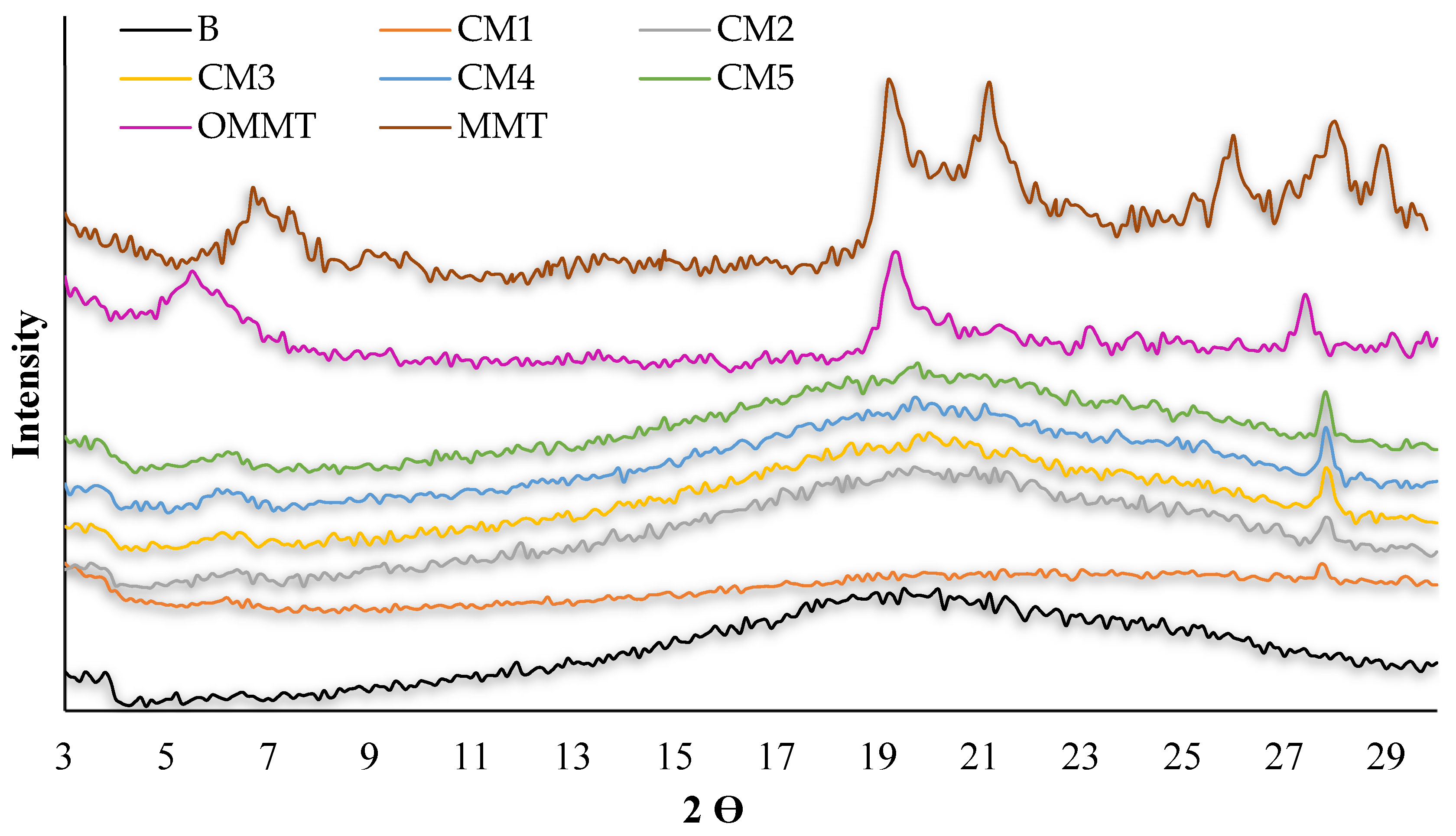
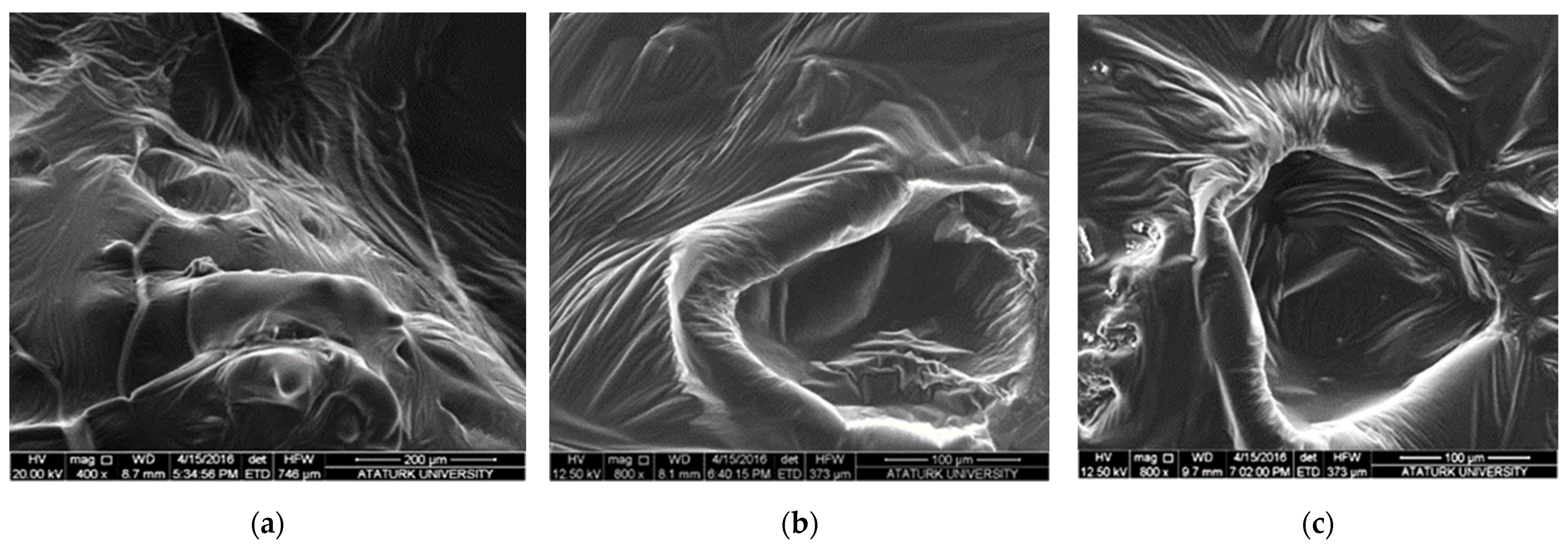

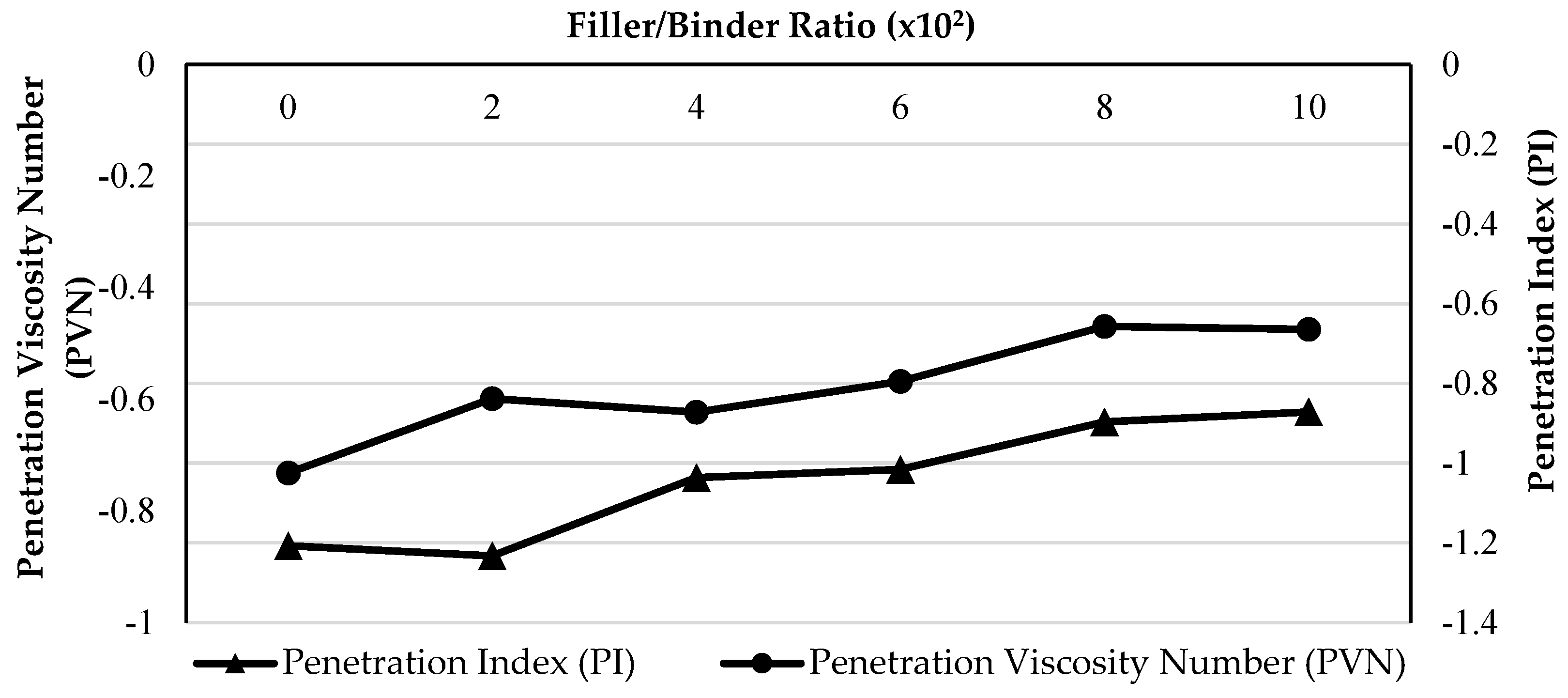
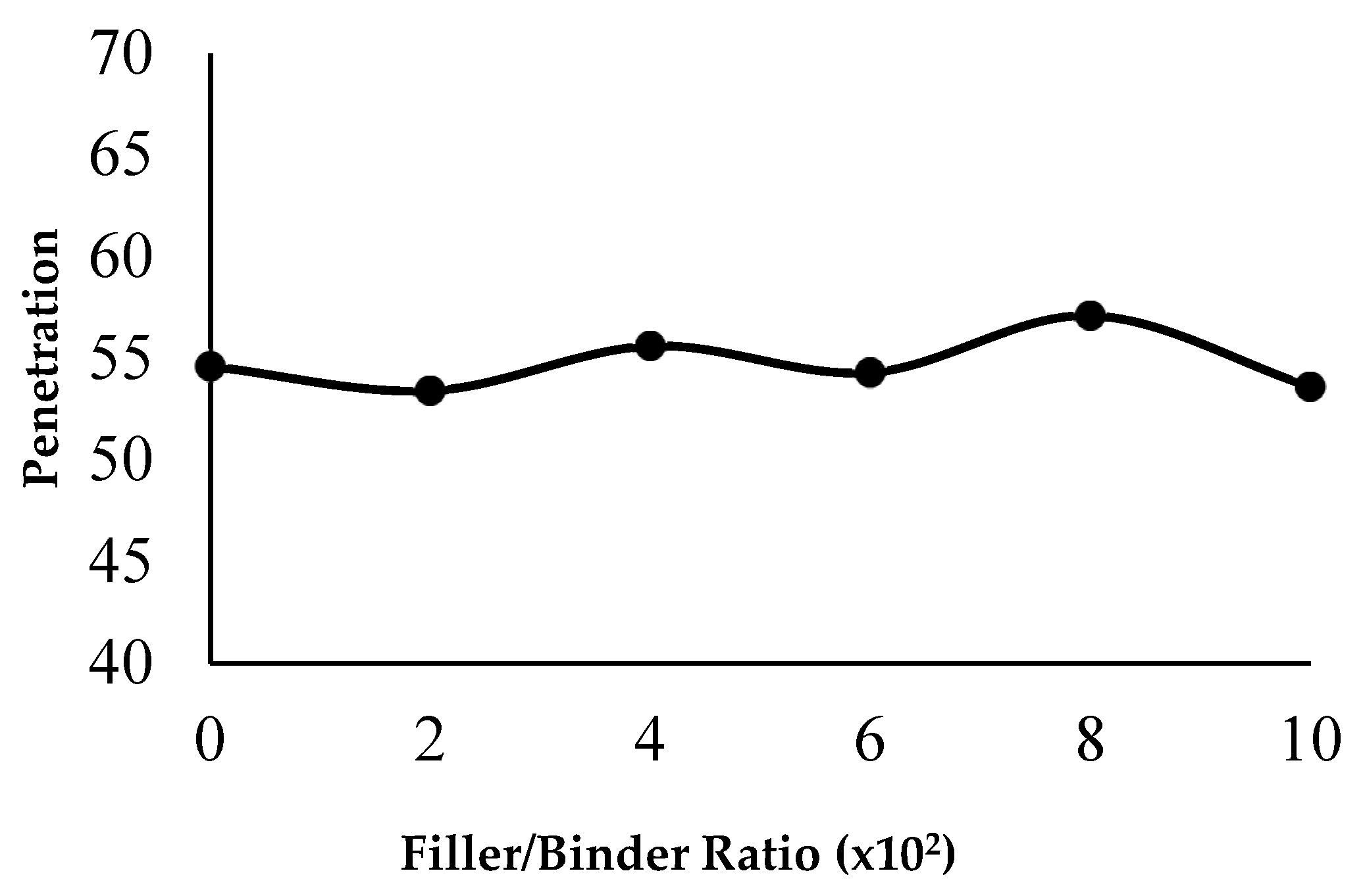
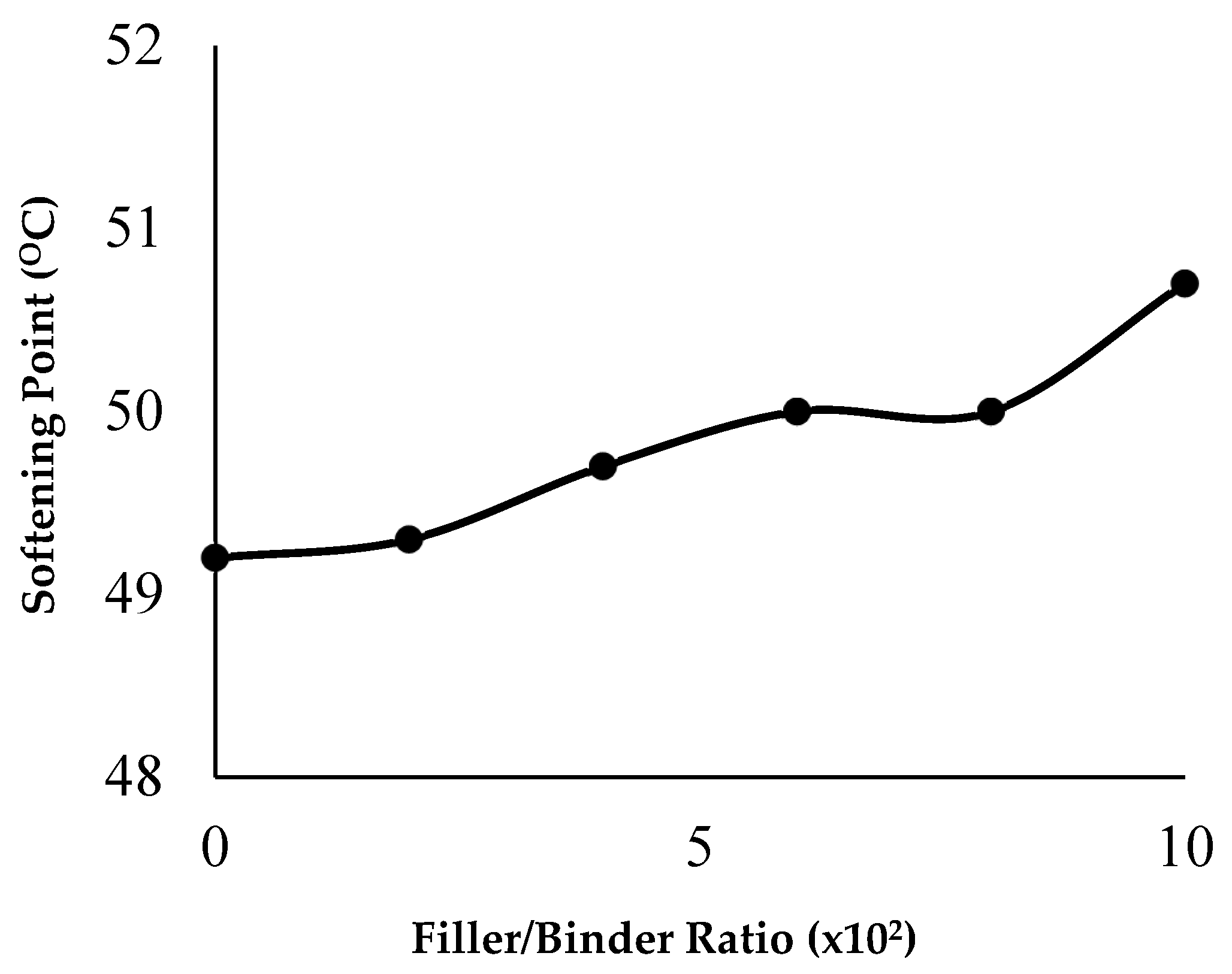
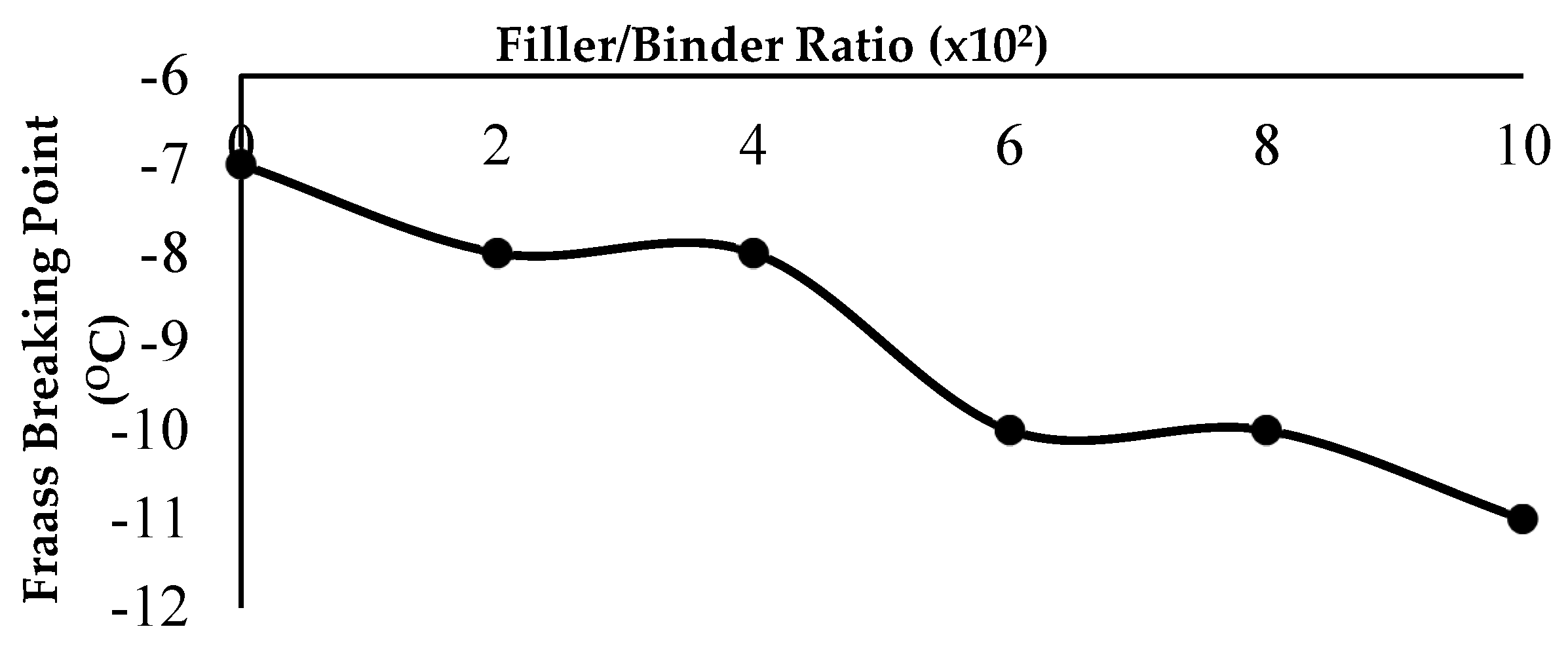
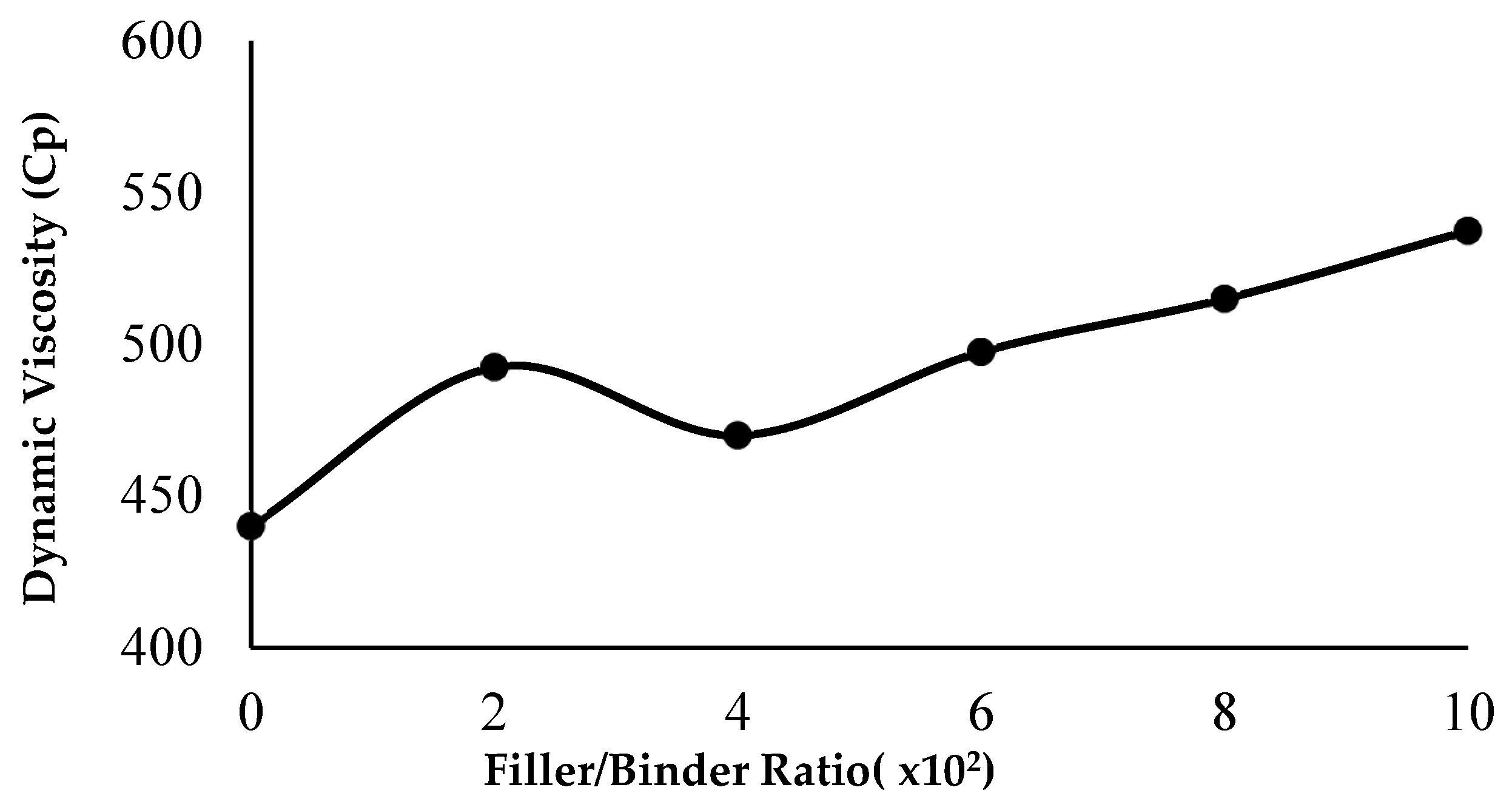
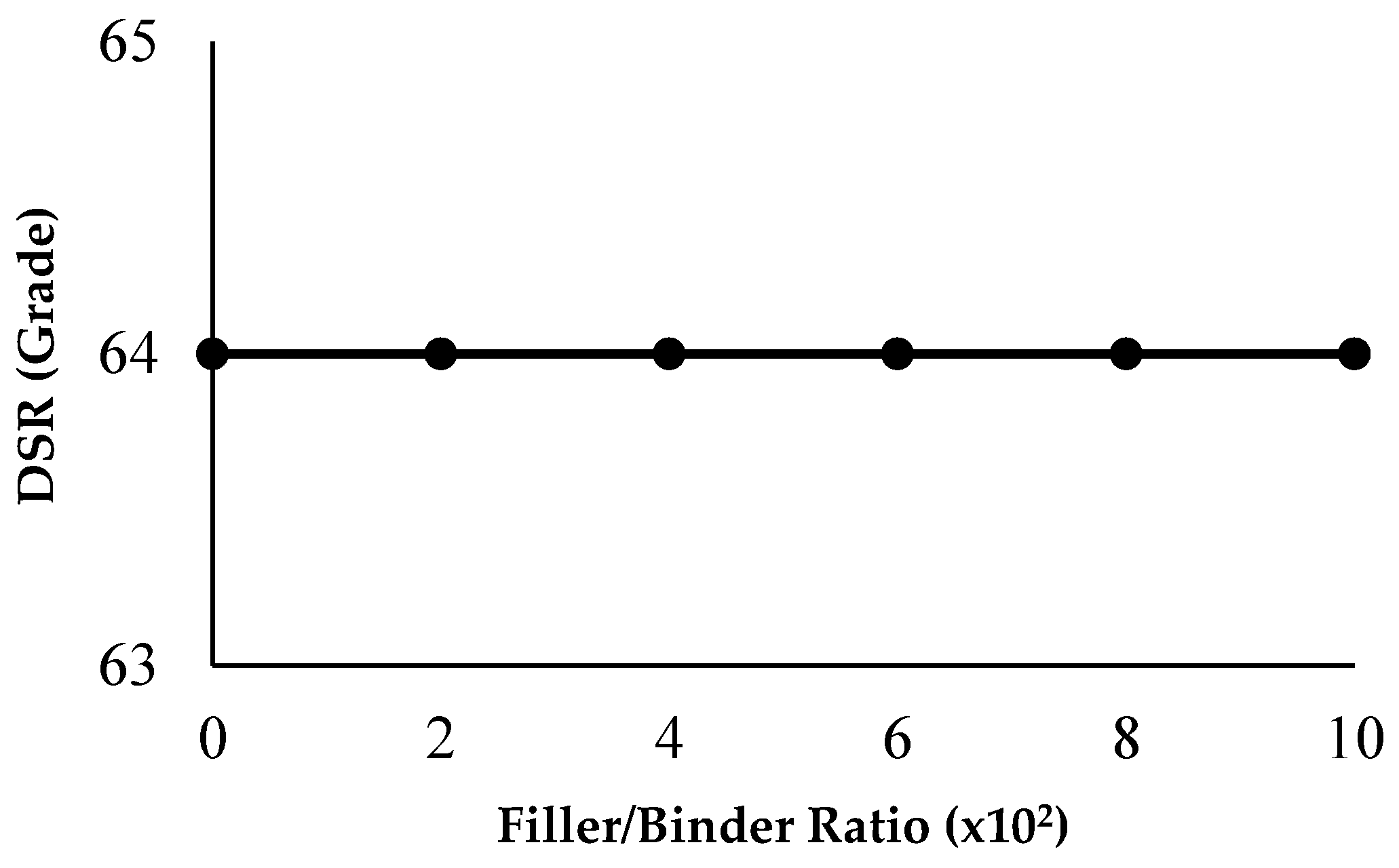
| Density (15 °C), kg/m3 | Calorific Value MJ/kg | Flash Point °C | Water by Distillation, wt. % | C | H | N | S | Ash |
|---|---|---|---|---|---|---|---|---|
| 990.7 | 42.74 | 105.8 | 0.1 | 83.4 | 11.9 | 0.8 | 1.5 | 0.03 |
| Components (%) | |||||||||
|---|---|---|---|---|---|---|---|---|---|
| SiO2 | Al2O3 | Fe2O3 | MgO | CaO | Na2O | K2O | TiO3 | SO3 | Other |
| 59.32 | 17.19 | 5.95 | 3.63 | 2.21 | 1.68 | 0.97 | 0.74 | 0.51 | 7.81 |
| Test | Value | Standard |
|---|---|---|
| Penetration (25 °C, 100 g, 5 min) | 54.6 | TS 1081 EN 12591 |
| Softening Point (°C) | 49.2 | TS EN 1427, ASTM D36 |
| Flash Point (°C) | 342 | TS EN ISO 2592, TS 1171 |
| Elastic Recovery % | 0 | TS EN 13398 |
| Dynamic Viscosity (Cp) | 440 | TS 1451 EN ISO 3104 |
| DSR (Dynamic Shear Rheometer) (GRADE) | 64 | TS EN 14770, AASHTO T315 |
| Fraass Breaking Point (°C) | −7 | TS EN 12593 |
| Test | PMB 64-28 | PMB 70-16 | PMB 70-22 | PMB 70-28 | PMB 76-16 | PMB 76-22 |
|---|---|---|---|---|---|---|
| Penetration (25 °C, 100 g, 5 min) | 50–90 | 30–70 | 30–90 | 20–60 | 20–70 | 10–50 |
| Softening Point (°C) | 52 | 62 | 62 | 62 | 67 | 67 |
| Elastic Recovery % | 80 | 60 | 70 | 80 | 60 | 70 |
| Flash Point (°C) | 220 | 220 | 220 | 220 | 220 | 220 |
| DSR (Dynamics Shear Rheometer) (GRADE) (G/Sin δ > 1 kPa) | 64.0 | 70.0 | 70.0 | 70.0 | 76.0 | 76.0 |
| Specimen Code | Type of Bitumen | Filler | Filler/Binder Ratio |
|---|---|---|---|
| B | 50/70 | Base Bitumen | 0.00 |
| CM1 | 50/70 | Hydrocarbon-doped organo-clay | 0.02 |
| CM2 | 50/70 | Hydrocarbon-doped organo-clay | 0.04 |
| CM3 | 50/70 | Hydrocarbon-doped organo-clay | 0.06 |
| CM4 | 50/70 | Hydrocarbon-doped organo-clay | 0.08 |
| CM5 | 50/70 | Hydrocarbon-doped organo-clay | 0.10 |
| Test | B | CM1 | CM2 | CM3 | CM4 | CM5 |
|---|---|---|---|---|---|---|
| Penetration (25 °C, 100 g, 5 min) | 54.6 | 53.4 | 55.6 | 54.3 | 57.1 | 53.6 |
| Softening Point (°C) | 49.2 | 49.3 | 49.7 | 50.0 | 50.0 | 50.7 |
| Flash Point (°C) | 342.0 | 338.0 | 336.0 | 340.0 | 336.0 | 340.0 |
| Elastic Recovery % | 0.0 | 0.0 | 0.0 | 0.0 | 0.0 | 0.0 |
| Dynamic Viscosity (Cp) | 440.0 | 492.5 | 470.0 | 497.5 | 515.0 | 537.5 |
| DSR (Dynamic Shear Rheometer) (GRADE) | 64.0 | 64.0 | 64.,0 | 64.0 | 64.0 | 64.0 |
| Fraass Breaking Point (°C) | −7.0 | −8.0 | −8.0 | −10.0 | −10.0 | −11.0 |
| Samples | ||||||
|---|---|---|---|---|---|---|
| B | CM1 | CM2 | CM3 | CM4 | CM5 | |
| Penetration Index (PI) | −1.2072 | −1.2328 | −1.0366 | −1.0161 | −0.8967 | −0.8715 |
| Penetration Viscosity Number (PVN) | −0.7321 | −0.5988 | −0.6231 | −0.5682 | −0.4694 | −0.4749 |
Disclaimer/Publisher’s Note: The statements, opinions and data contained in all publications are solely those of the individual author(s) and contributor(s) and not of MDPI and/or the editor(s). MDPI and/or the editor(s) disclaim responsibility for any injury to people or property resulting from any ideas, methods, instructions or products referred to in the content. |
© 2023 by the authors. Licensee MDPI, Basel, Switzerland. This article is an open access article distributed under the terms and conditions of the Creative Commons Attribution (CC BY) license (https://creativecommons.org/licenses/by/4.0/).
Share and Cite
Gürses, A.; Barın, T.B. Preparation, Structural Characterization and Evaluation of Some Dynamic and Rheological Properties of a New Type of Clay Containing Mastic Material, Clay-Mastic. Minerals 2023, 13, 705. https://doi.org/10.3390/min13050705
Gürses A, Barın TB. Preparation, Structural Characterization and Evaluation of Some Dynamic and Rheological Properties of a New Type of Clay Containing Mastic Material, Clay-Mastic. Minerals. 2023; 13(5):705. https://doi.org/10.3390/min13050705
Chicago/Turabian StyleGürses, Ahmet, and Tahsin Barkın Barın. 2023. "Preparation, Structural Characterization and Evaluation of Some Dynamic and Rheological Properties of a New Type of Clay Containing Mastic Material, Clay-Mastic" Minerals 13, no. 5: 705. https://doi.org/10.3390/min13050705
APA StyleGürses, A., & Barın, T. B. (2023). Preparation, Structural Characterization and Evaluation of Some Dynamic and Rheological Properties of a New Type of Clay Containing Mastic Material, Clay-Mastic. Minerals, 13(5), 705. https://doi.org/10.3390/min13050705










